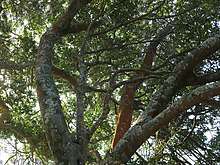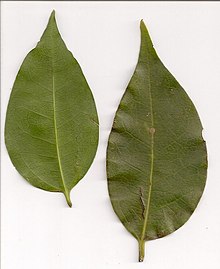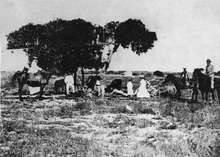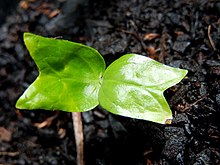Celtis paniculata
Celtis paniculata is a coastal rainforest tree. In Australia it occurs from Kiama (34° S) in New South Wales to the Endeavour River (15° S) in tropical Queensland. It also grows at Norfolk Island, eastern Malesia, Micronesia, and Polynesia. In Australia it is commonly known as native celtis or investigator tree. Often seen in coastal areas, but may also be found up to 800 metres above sea level.[1][2]
| Investigator Tree | |
|---|---|
 | |
| tree at Bass Point, Australia | |
 | |
| Celtis paniculata mature leaves | |
| Scientific classification | |
| Kingdom: | Plantae |
| Clade: | Tracheophytes |
| Clade: | Angiosperms |
| Clade: | Eudicots |
| Clade: | Rosids |
| Order: | Rosales |
| Family: | Cannabaceae |
| Genus: | Celtis |
| Species: | C. paniculata |
| Binomial name | |
| Celtis paniculata | |
| Synonyms | |
| |
Description
The tree grows to 40 metres tall and 90 cm in trunk width, though usually much smaller. The trunk is mostly cylindrical and somewhat buttressed at the base. The bark is thin, greyish brown and smooth, with pustular vertical lines.[1]
Leaves
Leaves are elliptical in shape with a prominent leaf tip. Leaves are alternate and simple, smooth, not toothed, 6 to 10 cm long with a pointed tip. The leaf stalk is somewhat channelled and flattened on the top, and 6 to 10 mm in length. Both sides of the leaf are of a dull green shade. With a hand lens, translucent glands may be seen in the leaves. The base of the leaf is often oblique, that is of unequal length on either side of the leaf stem. Leaf venation is more evident under the leaf. An identifying feature is the intramarginal leaf vein, which starts at the leaf base and travels on either edge of the leaf, a distance of ¼ to ½ the length of the leaf.[1][3]
Taxonomy & Naming
This plant first appeared in scientific literature as Solenostigma paniculatum in 1833, published in the Prodromus Florae Norfolkicae by the Austrian botanist Stephan Endlicher. The type specimen was collected at Norfolk Island by the artist Ferdinand Bauer. The specific epithet paniculata refers to the tufted and branched flowers.[1]In 1848 Jules Émile Planchon moved the species to the Celtis genus. Other common names include Native Hackberry, Silky Keltis, Silky Celtis, Tripewood and Whitewood.[1]
Investigator Tree
The original "Investigator Tree" grew on Sweers Island in the Gulf of Carpentaria, named after Matthew Flinders' ship. The island was an important port on a major thoroughfare for 19th century Australian explorers. Later members of other expeditions in Australia’s maritime history made carvings on this tree.[4]
Germination and seedlings
Removal of the flesh from the seed is not advised when sowing. Germination takes between 48 to 71 days. The cotyledons are large, about 30 x 25 mm with an apex divided into two acute lobes. The first pairs of juvenile leaves are often toothed. At the tenth leaf stage leaves become oval in shape with a prominent tip.[2]
Ecology & Uses
Celtis paniculata is a food tree for the blue beak, common aeroplane, tailed emperor and other butterflies.[5] Many rainforest pigeons and other birds feed on the fruit.[6] An endangered population of the beetle Menippus darcyi feeds on Celtis paniculata.[7] The tree produces a useful general purpose timber, with a specific gravity of 0.70.[2]

References
- Floyd, A. G. (2008). Rainforest Trees of Mainland South-eastern Australia (2nd, Revised ed.). Lismore, New South Wales: Terania Rainforest Publishing, copyright Forestry Commission of New South Wales. p. 92. ISBN 0-958943-67-2. Retrieved 2020-07-19.
- "Celtis paniculata". Australian Tropical Rainforest Plants. Retrieved 19 July 2020.
- Gwen Harden. "Celtis paniculata". PlantNET, New South Wales Flora Online. Retrieved 19 July 2020.
- "H43029.1 CH classification EXPLORATION Terrestrial tree section". Queensland Museum Network. Retrieved 18 July 2020.
- "Celtis paniculata". ala.org.au. Atlas of Living Australia. Retrieved 9 October 2019.
- "Fleshy Fruited Food Trees of Northern New South Wales" (PDF). Environment - New South Wales Government. Retrieved 19 July 2020.
- "Menippus darcyi (a beetle) population, Sutherland Shire - endangered population listing ". NSW Department of Planning, Industry and Environment - New South Wales Government. Retrieved 19 July 2020.
